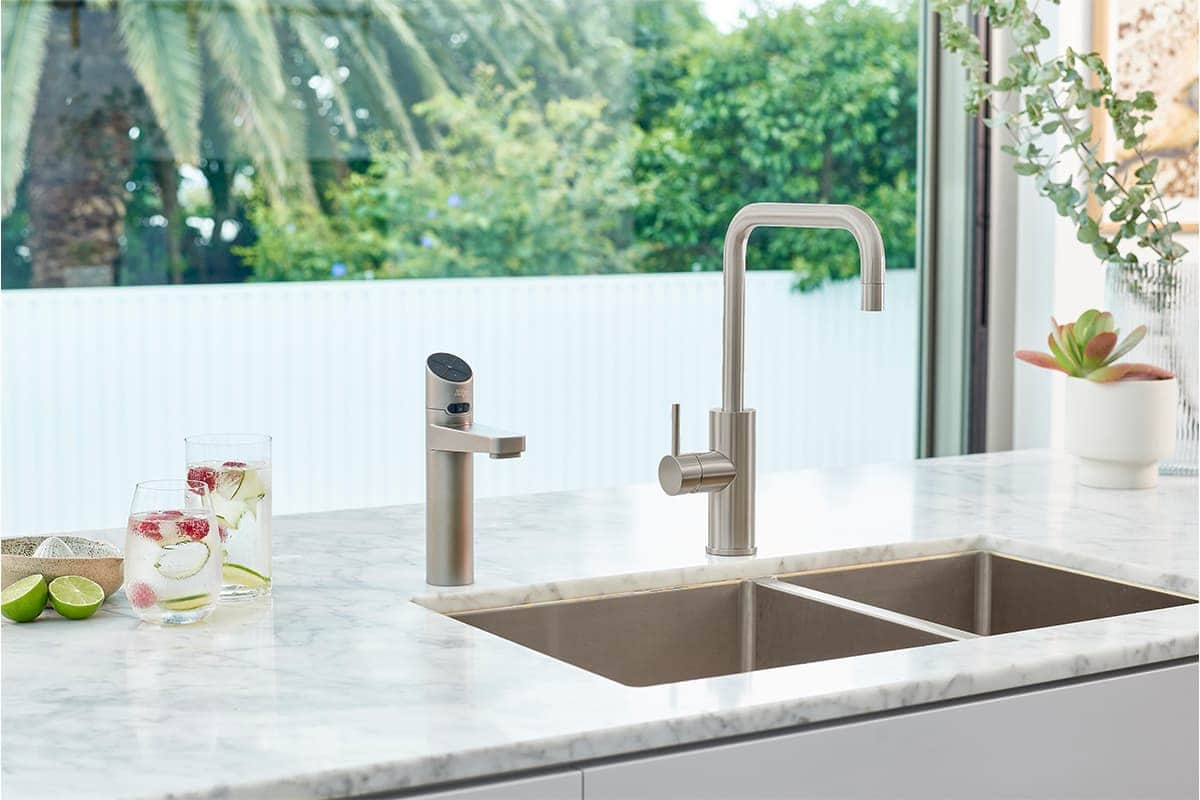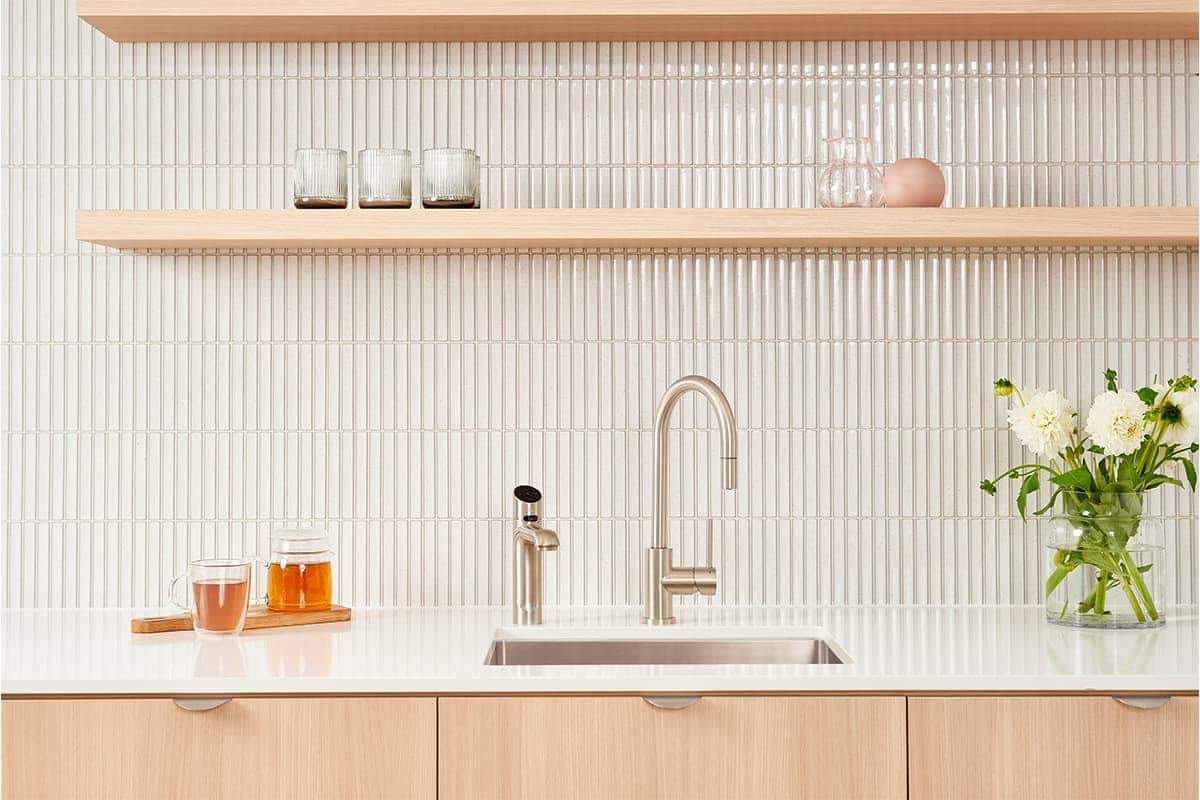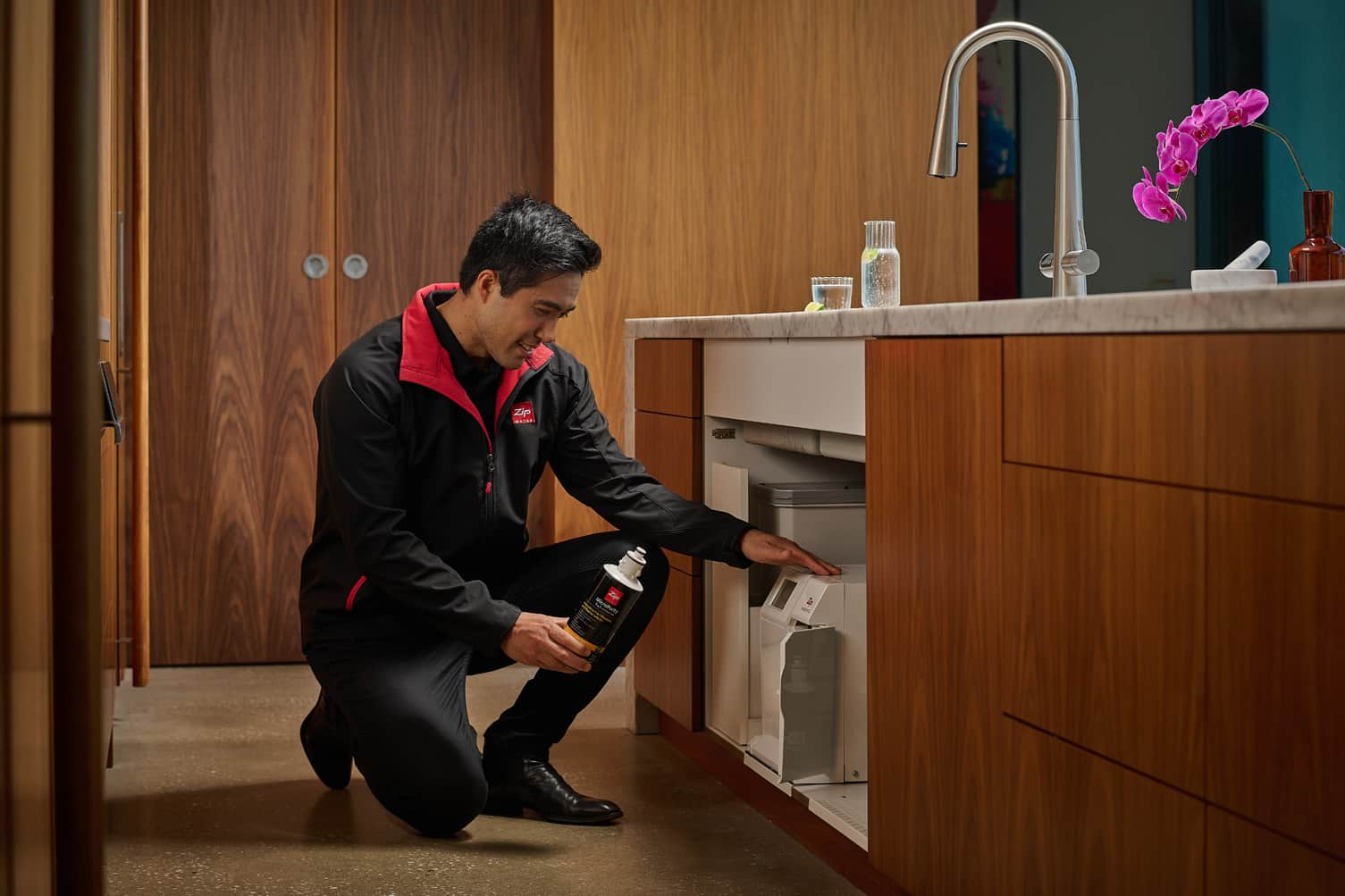Is Tap Water Safe to Drink in Australia?
Design | 06-05-25

You turn your tap on without thinking. Maybe to fill a glass or rinse fruit for your kids’ lunchboxes.
We’re lucky in Australia – most of us can confidently drink straight from the tap. Our water is among the cleanest and most regulated in the world.
But what’s actually in your glass? Is tap water in Australia really as safe to drink as we think?
Let’s take a closer look at what comes out of our taps – and how you can make it better.
We’ll cover:
In this guide to the benefits of drinking sparkling water, we’ll cover:
- Is tap water safe to drink in Australia?
- What’s in tap water
- Water quality across Australia
- Older homes vs newer homes
- Water filtration
- And some helpful FAQ
Let’s start with the basics: is Australian tap water safe to drink?
Is tap water safe to drink in Australia?
Yes – Australian tap water is safe to drink in most places. It’s regulated under the Australian Drinking Water Guidelines and managed by local health departments and water utilities. Tap water is regularly tested for bacteria, heavy metals, and other known risks – and must meet strict national standards.
The drinking water guidelines are part of the National Water Quality Management Strategy and are ultimately managed by the National Health and Medical Research Council.
But here’s the thing: “safe” doesn’t always tell the whole story.
Water quality can vary depending on where you live, the pipes in your home, and even how long the water sits before you use it. What comes out of the tap might be perfectly legal and safe – but not always what you want in your glass.
That’s why it’s worth understanding what’s actually in your tap water, how it’s treated, and what can affect it once it leaves the treatment plant and enters your home.
Let’s look closer at what’s added, what’s removed, and what that means for you.
What’s in our water (and what’s taken out)?
When you turn on the tap, the water looks clean. But even the best-treated water comes with a few invisible extras. Some of them are meant to be there. Others, not so much.
Here’s what you’ll usually find in Australian tap water – and why.
What’s added (on purpose)
Chlorine
Part of why tap water is safe to drink in Australia is because chlorine is added to kill bacteria and viruses. It’s what keeps your water safe all the way from the treatment plant to your tap. But it can also affect how your water tastes and smells.
Fluoride
Fluoride is used to help prevent tooth decay. It’s been in Australian drinking water for decades, and it’s supported by every major health body when used at safe levels.
What’s taken out
Before it reaches your glass, tap water is filtered and treated to remove all the usual suspects like sediment, harmful microbes and heavy metals. That’s a big part of what makes Australian tap water some of the best in the world.
But not everything is always filtered out. Let’s talk about two things you might have heard about: PFAS and microplastics.
These are known as emerging contaminants. They’re not new, but scientists are learning more about them and how they show up in our environment.
PFASPFAS (short for per- and poly-fluoroalkyl substances) are man-made chemicals used in everything from non-stick pans to stain-resistant fabrics. They’re sometimes called “forever chemicals” because they don’t break down easily – and small amounts have been found in water systems worldwide, including here in Australia.
Microplastics
Microplastics are tiny particles that come from things like packaging, clothing fibres, and even bottled water. Some can make their way into waterways and, eventually, into drinking water.
So, can you drink tap water in Australia? Yes, you can. Right now, Australian tap water is still considered very safe to drink. But you can filter your water if you’re concerned or you just don’t want these extras in your glass.
Just remember not all filters are created equal. Zip Water’s MicroPurity filters are certified to reduce PFAS by up to 99.4%*.
They also remove up to 99.9% of other contaminants, including microplastics, chlorine, lead and sediment bigger than 0.2 microns. That’s tiny. Small enough to catch things your eyes can’t see but your body might prefer to avoid.
So while your tap water might already meet national standards, there’s a simple way to make it better.
Does water quality vary across Australia?
Yes – water quality varies across the country, and it’s not just about whether tap water is safe to drink in Australia. It’s also about taste, clarity, and trust.
Australia’s water quality is generally excellent. But we live on a large and varied continent, and our water sources vary too. Where your water comes from and how it’s treated can make a big difference to what comes out of your tap.
Let’s take a quick tour around the country.
Melbourne
Some have praised Melbourne for having some of the best-tasting tap water in the world. Why? Much of it comes from protected catchments in the Yarra Ranges, requiring less treatment. Locals often describe it as clean, crisp and soft.
Sydney
Sydney also has high-quality tap water, drawn mainly from Warragamba Dam and treated at several plants across the region. Some people notice a mild chlorine taste, but it’s safe to drink from the tap and closely monitored.
Brisbane
Brisbane draws water from a mix of sources, including dams and weirs. The quality is strong, but some residents report a slightly earthy or mineral-heavy flavour, especially after heavy rainfall or drought.
Adelaide
Adelaide historically had a reputation for poor tap water taste, partly because it relies on the River Murray – one of the longest-travelled water sources in the country. Taste and smell have improved over time, but many people still prefer to filter it.
Perth
Water in Perth comes from dams, groundwater and desalination plants. While safe to drink, the taste can vary – particularly in suburbs where older infrastructure or high mineral content can change the flavour.
Canberra
Canberra generally has excellent quality, with water sourced from mountain-fed catchments. It’s treated carefully and usually tastes fresh. Still, chlorine levels can fluctuate, and some people choose to filter for taste.
Learn about water quality in Hobart and Darwin.
Regional towns and rural areas
This is where things can get patchy. Some towns rely on bore water, rainwater tanks, or small treatment facilities – each with its own challenges. While most are monitored for safety, the quality can vary more, especially after weather events or system issues.
Remote and First Nations communities
Unfortunately, not all Australians have the same access to clean drinking water. In some remote areas, tap water isn’t safe to drink. In those cases, the water doesn’t meet basic health guidelines due to old infrastructure, low-quality sources, or lack of consistent maintenance. It’s a known issue that authorities are addressing, but we’d like to acknowledge it. It’s also an important thing to know as a traveller.
The bottom line? Where you live (or where you’re staying) can change what your water tastes like (and what’s in it). It might be totally safe by the book, but still not quite what you want to drink every day.
That’s where a good filtration system can make all the difference. It gives you control, no matter what’s coming through the pipes.
Older homes vs newer homes: does it make a difference?
It can. Sometimes, tap water is less safe to drink in older Australian homes. Even if your local water supply is top quality, the pipes in your home can affect what comes out of the tap. That’s especially true in houses built before the mid-2000s.
Back then, it wasn’t unusual for plumbing to include lead-based solder or galvanised pipes. Over time, small amounts of lead or other metals can leach into your water – especially if it’s been sitting in the pipes overnight or while you’re away.
You won’t taste it, and you won’t see it. But that doesn’t mean it’s not there.
Newer homes are built to tighter standards, using safer materials. But even then, some modern fittings like taps or mixers can still contain small traces of lead or copper, particularly if they’re imported or haven’t been WaterMark certified.
So what can you do?
If your home is older, you could check your plumbing – especially if you’re renovating or you’re unsure what’s been used. A licensed plumber can easily test your water or inspect your pipes for peace of mind.
If you’re unsure, try running the cold tap for a few seconds each morning before using it for drinking or cooking. This helps flush out any water that’s been sitting in the pipes.
And if you’d rather not think about it at all? A HydroTap can help reduce contaminants like lead and sediment right at the tap. It’s a simple way to get more control over what you’re drinking, no matter how old your plumbing is.
Because safe water isn’t just about the source. It’s also about how it reaches your glass.
Is bottled water a good option?
We all reach for bottled water sometimes. At the airport, in the car, or when you’re caught out on a hot day.
But when it comes to your everyday drinking water at home or work, bottled water might not be the better option.
Let’s start with the facts:
- Bottled water isn’t necessarily cleaner or safer than tap water. Tap water in Australia is safe, clean, and held to strict national standards.
- It’s expensive. According to Sydney Water, one litre of bottled water can cost 2000 times more than the same amount from the tap.
- It’s not great for the planet. Even with recycling, bottled water uses plastic, transport, energy and storage. And the bottles often end up in landfill or waterways.
If you’re buying bottled water because you don’t like the taste or you’re unsure if your tap water is safe to drink, there’s a better way: filter your tap water.
Water filtration: do you really need it?
This one is a personal choice. If your tap water already meets Australian standards—and it probably does—you might wonder whether filtering it is worth it. And for some people, it might not be.
But if you want water that tastes better, smells fresh, or gives you peace of mind about what’s actually in your glass, then yes. A good filter makes a real difference.
Why do people choose to filter their water?
For some, it’s about removing chlorine or that faint metallic aftertaste. For others, it’s about reducing exposure to things like lead, microplastics or PFAS – especially if you’ve got young kids or someone in the house is immunocompromised.
And sometimes, it’s just about feeling confident in what you’re drinking. Because “safe enough” doesn’t always mean right for you.
Not all filters are equal
Filter jugs, tap attachments, under-sink systems – they all do different jobs. But the key thing to check is what they actually filter out.
Zip Water’s MicroPurity system filters down to 0.2 microns. That’s fine enough to catch up to 99.9% of the 8 most harmful contaminants you can't see including microplastics, asbestos and lead – along with 99.4% of PFAS*.
And because it filters your water right at the source, there’s no waiting, no filling jugs, and no second-guessing what you’re drinking.
It’s not just about safety. It’s about experience.
Great-tasting water makes everything better – from your morning cuppa to a glass of water on a hot day. With a Zip Water HydroTap, you can get filtered boiling, chilled and even sparkling water straight from the tap. No bottles. No clutter. Just good water on demand.
It’s an easy way to upgrade your kitchen—and your water quality—at the same time.
Browse our boiling water taps, chilled water taps or sparkling water taps to see which multi-function combination suits your needs best.
Final thoughts: what does “safe water” mean for you?
We need to be clear: tap water is safe to drink in Australia. But safe means different things to different people.
Maybe for you, it’s knowing your water meets national health guidelines. Maybe it’s knowing there’s no lead in the pipes. Maybe it’s about taste. Or trust. Or just wanting the best for your family every time they take a sip.
Australian tap water is among the best in the world – and that’s something to be proud of. But even with strong systems in place, a lot can still influence the quality of what actually comes out of your tap. Old plumbing. Regional variations. Contaminants we’re only just starting to understand.
That’s why more and more people are choosing to take things into their own hands.
Filtration isn’t about fear. It’s about feeling confident. Making your water as clean, fresh and enjoyable as possible – because you can.
With a Zip Water system, it’s one less thing to worry about and one more thing done right.
Are you still curious about your water? Learn about the benefits of filtered tap water or discover five easy ways to drink more water.
FAQ: Can you drink tap water in Australia?
Is Australian tap water better than bottled water?
In most cases, yes. Australian tap water is held to strict national safety standards and is tested regularly for quality. While bottled water is handy on the go, it’s far more expensive and creates more waste. If taste or trust is the issue, filtered tap water is a smarter everyday choice.
Do I need to filter my tap water?
Not necessarily. It depends on what matters to you. If you’re happy with how your water tastes and you trust your local supply, you may not feel the need to filter. Tap water is safe to drink in Australia. But a good filtration system gives you extra peace of mind if you’re concerned about things like chlorine, lead, microplastics or older pipes. It’s also a simple way to make your water taste better and feel more reliable, glass after glass.
* Zip MicroPurity filters sizes 1 and 1.5 (93701 and 93702) are certified to NSF/ANSI Standard 53 to reduce 99.4% of Total PFAS (average reduction).























